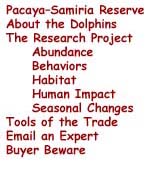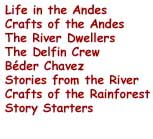|
Tuesday, November 14, 2000
Home Sweet Home
Ah, the Mirón Lento—our home for the next two weeks. It
is hard to imagine what life is like on a small boat deep in the Amazon
until you get on one. While we knew the Mirón Lento was a smaller
boat and that we would be living in more "rustic" conditions, none of
us was quite prepared for how rustic life would really be on this boat.
Fortunately, we are all adventurers of one kind or another and are up
for the challenge.
The Mirón Lento was built in 1993 as a research boat. It has
two decks and is about 17 meters from bow to stern and 3.5 meters wide.
We are living in close quarters indeed, particularly since there are
10 of us sharing this space for two weeks. There is virtually no privacy
or anywhere to "get away" from one another should we feel a need for
a little alone time.
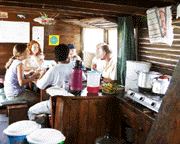  The
lower deck has a kitchen (a counter with a sink and a three burner,
portable stove) a table for eating, six bunks, and an engine room. There
is a curtain that separates the bunk area from the kitchen. Tamara has
a very small "space" at the front of the lower deck for herself. The
lower deck has a kitchen (a counter with a sink and a three burner,
portable stove) a table for eating, six bunks, and an engine room. There
is a curtain that separates the bunk area from the kitchen. Tamara has
a very small "space" at the front of the lower deck for herself.
The upper deck is one long, undivided space. The Captain's wheel is
at the bow. There are hard wooden benches along the left and right sides
near the front of the boat. This area is where we hang out during the
day and conduct our research. It is covered with a plastic tarp to keep
us out of the sun and protect us from the rain. The sides of this area
have plastic tarps, as well, that can be quickly rolled down in the
event of a storm.
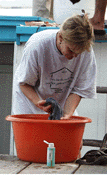 There
is an area at the back for washing clothes and hanging laundry. The
boat's solar panels that provide energy for the lights at night are
on the roof of the bathroom. The Virtual Explorers' solar panels are
placed on top of the awning to get the maximum amount of sun during
the day. There is a large freezer located just back of the covered area.
There is no generator on board, so the freezer isn't plugged into anything.
Instead, is packed with enough ice to keep two weeks of fresh food—fresh. There
is an area at the back for washing clothes and hanging laundry. The
boat's solar panels that provide energy for the lights at night are
on the roof of the bathroom. The Virtual Explorers' solar panels are
placed on top of the awning to get the maximum amount of sun during
the day. There is a large freezer located just back of the covered area.
There is no generator on board, so the freezer isn't plugged into anything.
Instead, is packed with enough ice to keep two weeks of fresh food—fresh.
Last year on the Delfín, we had four bathrooms and separate
cabins for sleeping. We actually thought we were a bit cramped then.
How silly! If we only knew then that we'd be coming back to live on
the Mirón Lento, we would have thought the Delfin a floating
five star hotel.
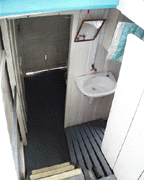  Instead,
we have only one bathroom. Like the Delfín, the shower is located
right next to the toilet so everything gets wet when you take a shower.
Shower water is nothing other than river water in a holding tank located
on top of the bathroom. Letser refills the reservoir with five-gallon
bucket a couple of times a day. Showering in this heat makes you feel
good for about five minutes, after which you are immediately hot and
sweaty once again—but boy are those five minutes wonderful! After
24 hours we all have discovered the necessary technique for flushing
the toilet (which flushes right into the river). There is no handle
for flushing. Instead, there is a bucket of river water with a scoop
right beside the toilet. To flush, you take a scoop of water and pour
it in the toilet. However, to be effective, your aim needs to be dead
center and you need to practically throw the water in the toilet. Takes
a little practice, but by now we have all mastered it. Instead,
we have only one bathroom. Like the Delfín, the shower is located
right next to the toilet so everything gets wet when you take a shower.
Shower water is nothing other than river water in a holding tank located
on top of the bathroom. Letser refills the reservoir with five-gallon
bucket a couple of times a day. Showering in this heat makes you feel
good for about five minutes, after which you are immediately hot and
sweaty once again—but boy are those five minutes wonderful! After
24 hours we all have discovered the necessary technique for flushing
the toilet (which flushes right into the river). There is no handle
for flushing. Instead, there is a bucket of river water with a scoop
right beside the toilet. To flush, you take a scoop of water and pour
it in the toilet. However, to be effective, your aim needs to be dead
center and you need to practically throw the water in the toilet. Takes
a little practice, but by now we have all mastered it.
The Race is On
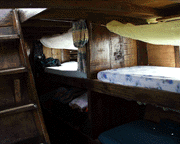 Darkness
comes quickly this close to the equator, so night seems to sneak up
on us. This is important because once night falls, the bugs come out
in force. There are two places to sleep on the Mirón Lento; small
bunks and the top open deck. The bunks are next to the kitchen area
and are like shelves built into the side of the boat. On each there
is a thin mattress and most importantly, mosquito netting. Darkness
comes quickly this close to the equator, so night seems to sneak up
on us. This is important because once night falls, the bugs come out
in force. There are two places to sleep on the Mirón Lento; small
bunks and the top open deck. The bunks are next to the kitchen area
and are like shelves built into the side of the boat. On each there
is a thin mattress and most importantly, mosquito netting.
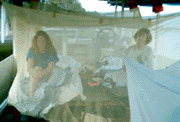  The covered
area upstairs becomes another sleeping area. The benches are pushed
together, mattresses are laid down and a huge canopy of mosquito netting
is hung to cover the entire "bed." This "Mosquito Palace" is really
the bed of choice on the boat. The "roominess" and fresh breeze all
night long makes it ideal. The covered
area upstairs becomes another sleeping area. The benches are pushed
together, mattresses are laid down and a huge canopy of mosquito netting
is hung to cover the entire "bed." This "Mosquito Palace" is really
the bed of choice on the boat. The "roominess" and fresh breeze all
night long makes it ideal.
We learned quickly last night that setting up the beds, especially
the mosquito netting is very important. As the sun begins to set, a
race begins between the mosquitoes and us. The task is to get the nets
up without letting mosquitoes inside. We weren't very much help with
this since it was also transmission time and we were busy with sending
our data via the satellite phone. Tonight we are going to have to do
it ourselves. Hopefully we won't have any new bug bites to complain
about tomorrow.
So Who Is Driving the Boat Anyway?
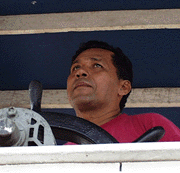 The
rivers of the Amazon are constantly changing, so there are no maps or
charts of the river. Captain Antonio knows the patterns of the water
and can read the river very well. He has been a boat captain for 20
years. He also has great eyes, pointing out dolphins long before the
rest of us. The
rivers of the Amazon are constantly changing, so there are no maps or
charts of the river. Captain Antonio knows the patterns of the water
and can read the river very well. He has been a boat captain for 20
years. He also has great eyes, pointing out dolphins long before the
rest of us.
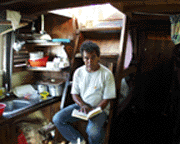  We
are excited that our cook from last year, Horatio, is our cook again.
He is able to create amazing meals in the tiny kitchen. This year he
has a cookbook that we can buy and take home, so we can have some of
our favorite meals from the Amazon at home. Horatio is currently reading
Harry Potter in Spanish! He has a 10-year-old daughter with whom he
wants to share the book. We
are excited that our cook from last year, Horatio, is our cook again.
He is able to create amazing meals in the tiny kitchen. This year he
has a cookbook that we can buy and take home, so we can have some of
our favorite meals from the Amazon at home. Horatio is currently reading
Harry Potter in Spanish! He has a 10-year-old daughter with whom he
wants to share the book.
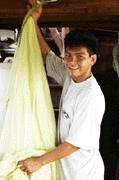 Letser
is the first mate and his main jobs are to help the Captain and keep
the boat looking good. He is in love with the captain's daughter, so
will do what ever the captain wants. Sometimes on the large Marañón
River, Letser takes a turn at driving the boat, but the captain takes
over when the river narrows or becomes more difficult to navigate. Letser
is the first mate and his main jobs are to help the Captain and keep
the boat looking good. He is in love with the captain's daughter, so
will do what ever the captain wants. Sometimes on the large Marañón
River, Letser takes a turn at driving the boat, but the captain takes
over when the river narrows or becomes more difficult to navigate.
The Daily Rhythm
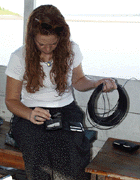  Our
goal this year is to actually enjoy the river, sleep for more than a
couple of hours a night and still do our job. So far, we are on our
way to reaching this goal. We are much better prepared—knowing
how much time things take and when work should be done. Last night our
transmission was finished by 8:00 P.M. Last year we were lucky to start
by then, and often didnŐt finish by midnight! We even had time to test
our temperature and light probes with our Palm handheld computers. We
will need these tomorrow. Our
goal this year is to actually enjoy the river, sleep for more than a
couple of hours a night and still do our job. So far, we are on our
way to reaching this goal. We are much better prepared—knowing
how much time things take and when work should be done. Last night our
transmission was finished by 8:00 P.M. Last year we were lucky to start
by then, and often didnŐt finish by midnight! We even had time to test
our temperature and light probes with our Palm handheld computers. We
will need these tomorrow.
We are delighted (and relieved) that our solar panels are capable
of charging both our super batteries by mid-day and that the two batteries
are enough power for us to run three laptop computers, recharge our
satellite phone and our Palms each day. This weekend when we have a
little more time we will describe in detail the equipment we have with
us and how we are using it.
Jungle Symphony
The jungle is layered with sounds at night and can only be appreciated
once everyone is settled in bed and quiet. The first "layer" is the
constant hum of thousands and thousands of insects. Croaking frogs break
through this hum adding a regular rhythm that you can almost keep time
to. Above this, the cries of night birds break through with irregularity
and beauty. The most unusual is the call of the Hay Hay Mama. Their
cry sounds so much like a child weeping that the local people have a
story about it. The birds are reported to have once been lost children
who now spend their nights crying for their parents.
Mixed with this cornucopia of sound is the river. The swish of the
current and the dolphins' "phew" as they break the surface to breathe
are constant companions all night long.
Today we traveled up the Río Marañón to San Pablo
Lake where we will spend the night. We encountered some dolphins along
the way and will share the data with you tomorrow. You may want to review
the background information about the two species
of river dolphins found here and the research tools.
In particular, you will want to read about how we do a transect survey.
We have also posted a map of our location that
we will update periodically.
|




